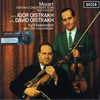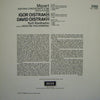



Mozart - Sinfonia Concertante K.364 & Duo In G K.423 - Igor Oistrakh, David Oistrakh,Kyril Kondrashin, Moscow Philharmonic
RARITY - SEALED
Wolfgang Amadeus Mozart - Sinfonia Concertante In A Flat Major For Violin, Viola And Orchestra K. 364 & Duo For Violin And Viola In G Major K. 423
Viola – David Oistrakh
Violin – Igor Oistrakh
Orchestra – Moscow Philharmonic Orchestra
Conductor – Kyril Kondrashin
1 LP, Standard Sleeve
Original analog Master tape : YES
Heavy Press : 180g
Record color : black
Speed : 33 RPM
Size : 12'’
Stereo
Studio
Record Press : Pallas
Label : Speakers Corner
Original Label : Decca
Recorded on 27 Sep 1963 at West Hampstead Studio 3
Engineered by Kenneth Wilkinson
Produced by Ray Minshull
Liner Notes by Erik Smith
Originally released in February 1964
Reissued in February 1997
Tracks:
Side A : Sinfonia Concertante In A Flat Major For Violin, Viola And Orchestra K. 364
- Allegro Maestoso
- Andante
- Presto
Side B : Duo For Violin And Viola In G Major K. 423
- Allegro
- Adagio
- Rondeau, Allegro
Reviews:
“I must confess I had the London LP version some years ago and a few years ago replaced it with the improved Speakers Corner vinyl reissue, but evidently hadn’t really ever sat down to listen closely to it. I found the Sinfonia a revelation – with a more serious mood than most of the composer’s lighter concertos and divertimenti. Mozart was going thru an especially difficult time in his life when he wrote the work. The two solo voices of the violin on one side of the soundstage and the viola on the other are captivating and ramp up the excitement of hearing the work. The great Russian violinist David Oistrakh gave the stronger violin part to his son Igor and took the secondary viola part for himself. The same is true of the “filler” work, the Duo.
Sonic presentation is absolutely lovely, with the two string instruments a bit forward of the orchestra but not in your face as are some of the Heifetz violin concerto recordings. There’s never even a suggestion of “digititus” in the string tone. The orchestra is displayed in great width and depth. In the middle Andante movement is the most sorrowful-sounding music, though still communicated with the utmost grace and melody. The finale is half the length of the previous two movements and concludes things with a fast-moving and much more optimistic flavor." Audiophile Audition Review by John Sunier
Ratings :
Discogs : 4.66 / 5



